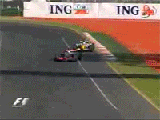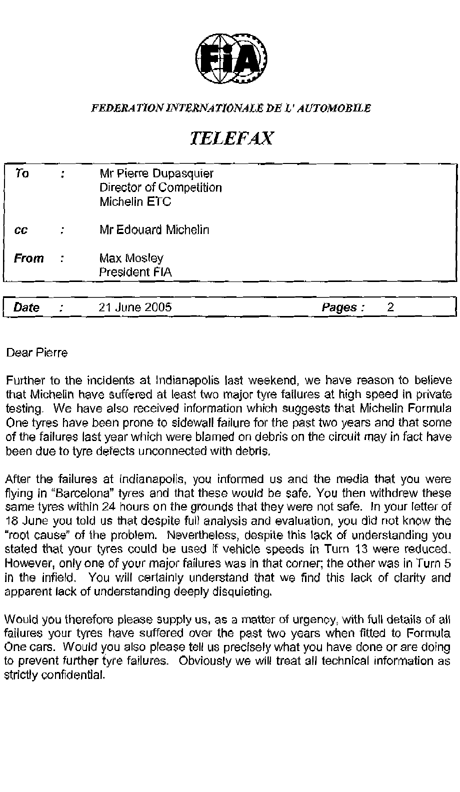Ciro Pabón wrote:Exactly my point. Schumacher had a failure in a high speed curve. This happens in NASCAR all the time. The walls wear because of flexing under low pressure, I've told that already. This could mean they were trying to low the heat, but trying to conserve the thread they ruined the walls. Duh.
WhiteBlue wrote:It may be ok for American oval racing with banked corners, but in my view side wall failures are not acceptable in F1 racing.
Well, tyres' structural failures
somehow are a lesser regulatory concern in NASCAR. Ultimately the cost can be measured in lives anyhow, and the tyre philosophy is vastly different to Formula One (
or any other car racing series for that matter). On heavily banked ovals the drivers can choose the direction of the stress to the tyre by their driving line, a properly heated tyre with higher pressure being able to withstand higher asymmetric forces. There seems to be more complacency about the manageability of the structure as a whole, not just the tread. Perhaps this is found acceptable because there is a "tool" to manage the structure too, but it certainly isn't something F1 teams can readily relate to. Nor should they.
This reminds me of a relatively recent Gordon Kirby article, where open wheel rookies' performances in NASCAR were discussed. In fact, the tyres are so narrow that cars tend to squirm under the loads and part of controlling (
apart from driver skill) this includes "sideforce" i.e. aerodynamic elements that provide directional stability. A direct quote from "
Dario Franchitti and Patrick Carpentier discuss their early NASCAR lessons"; the quote also illustrates why a NASCAR comparison is perhaps the least pertinent of all four wheel track motorsports to Formula One's tyres:
Gordon Kirby wrote:"When you first go out you need to run around the top of the track," Sadler told Carpentier. "You've got to take care of that right front tire. You can't be runnin' 'round the bottom. When you do that, you're overloadin' the right front. That's what you're doin'. You're tearin' up the right front in the first laps of the run so you're no good at the end. You've gotta bring the tires in carefully. Then you can go to the bottom."
This is one of the biggest things for an open-wheel driver to adapt to because Goodyear's tires are nothing like as effective or consistent in performance over the course of a run compared to Bridgestone/Firestone's superb tires which all Formula 1, Indy and Champ car drivers are used to. Incredibly, tire failures are common in NASCAR in the 21st century, and Goodyear's rubber may be the only racing tires extant in today's world where physical failures are accepted as normal. Coping with tires that can fail and regularly lose their performance edge dramatically is something new for Franchitti and his open-wheel colleagues.
"There are several things happening," Dario observed. "There's the weight of these cars and the tire is so bloody small that it's under a hell of a lot of stress. But it's a long time since I've driven a tire that fades. I was a Bridgestone/Firestone guy for twelve or thirteen years and I worked pretty hard developing the tires with those guys and they didn't really degrade. It was very unusual if you went to a track and the tires did degrade.
"But you're stressing the tires so much more here with the Goodyears. I'm getting used to how you have to set the car up to be loose at the start of a run and drive through that looseness so it doesn't push like a pig at the end."
As WhiteBlue stated, McLaren's was not a degradation or a wear issue, but a structural integrity issue. And not a structural integrity issue relating to tread degradation or wear either. While their car is said to produce a comparatively high amount of front downforce (
and while front end L/D ratio is relatively advantageous), they certainly hadn't cranked it up to a level that jeopardised Hamilton's race pace - as evidenced by his finish position.
His setup of choice was no panic solution, outside parameters, compensating for some deficiency either, but the team did it in good faith. Only after the practice did Bridgestone come back to them to warn them off a long stint strategy and an aggressive driving line through turn eight. There's nothing suggesting that McLaren or Hamilton were operating tyres beyond Bridgestone's specifications before. I suspect even in the best of days they're pretty dependent on Bridgestone track engineers' councel when it comes to adjusting tyre parameters. If you did a poll with the teams' technical directors on whether the tyres' sidewalls' integrity is or should be a race tactical issue, the answer should be quite uniform and definite.
As to the rest of Ciro's latest message providing a historical perspective to tyre failures, it is remarkably similar in its examples, structure and historical comprehensiviness to a grandprix.com article from June 2nd, 2005: "
The question of tyres and accidents". I strongly recommend reading the entire article. If only one had found that in time and provided a link, some trouble would've been spared I'm sure.
It's a thoroughly good read and examines the issue from many an angle, and despite our exhaustive exchange I found it most pertinent and useful nonetheless. Remarkably, while the grandprix.com article is generally in an uncanny agreement with Ciro's examples, their end conclusion stands in start contrast to his. Drivers shouldn't be worried about their tyres, there must not be a safety concern to the tyre that keeps them from driving to the full extent of their capabilities. This was of course highlighted in 2005 when the single tyre rule was in effect, but certainly applies to holding back to protect a structural element. Managing wear predictably is another matter altogether. The article finishes with this stark reminder:
Grandprix.com wrote:There is much discussion needed. The conclusion that one reaches in all of this is that the people in the sport should be talking to one another about such matters. Talk is cheap. Lives are not.
And that is the culmination point of this as far as I can see.
Ultimately the responsibility Bridgestone was concerned with wasn't if and how a driver could finish a race, but whether he would survive. A team and its drivers should be able to take it as a given that any margins of error do not cut that close to ultimate disasters, under any conditions. That being said, everyone reacted responsibly to the emergence of the unexpected problem and every once in a while even the best of us get caught off guard.
As stated by the grandprix.com piece, when Bridgestone was the only tyre supplier during the '90s there were a number of tyre failures nonetheless. Companies, perhaps due to the tradition and atmosphere of F1, will function pretty close to the limit even when they have a monopoly. I hope this will have Bridgestone adopt vastly larger margins for their slicks design, especially as there's no telling (
accurately) what the teams can deliver within the rules. For energy recovery's sake alone, demands will remain extraordinarily high.






